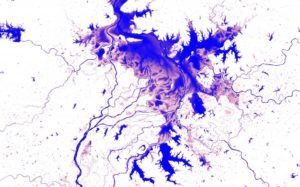by B. Irvine, May 17, 2021 in WUWT
A knowledge of Greenhouse gases is fundamental to any understanding of global surface temperatures. The presence of GHGs in our atmosphere has increased the global surface temperature by about 33C.
There are multiple lines of evidence, however, that challenge the strong water vapour feedback to a small initial CO2 forcing. These strong positive feedbacks are central to the IPCC narrative.
These lines of evidence include.
- The failure of all models and catastrophic warming projections.
- The stubborn refusal of atmospheric Precipitable Water Vapour (PWV) concentration to rise in recent years.
- The strength of convection cells in the tropics that have kept tropical temperatures approximately the same for many millions of years.
- Irrigation and extra humidity generally coincide with cooler temperatures.
- The hot spot as a signature of the positive Water Vapour (WV) feedback and its opposite, the negative lapse rate feedback, has not occurred.
INTRODUCTION
…
by EU Science Hub, Oct 2020
The Atlas provides a better understanding of the consequences climate change and human actions have for the planet’s surface water resources.
It is impossible to overstate the critical importance of water in our daily lives. Surface water bodies – including lakes, ponds and rivers – are particularly important as sources of water for domestic, industrial and agricultural use.
As the Earth’s surface water is intensely dynamic, our knowledge about where waterbodies can be found has not always been accurate. Waterbodies move, whole lakes dry up and new rivers and lakes form, which makes mapping these moving targets difficult.
Building on a project that combined thousands of years of computer time with millions of satellite images, the JRC’s Atlas of Global Surface Water Dynamics describes the important role that surface water plays for our planet’s climate and biodiversity, as well as virtually every aspect of our daily lives.
The Atlas documents the science behind a set of truly unique maps, which include time, and illustrates the changes in surface water resources over the past 35 years.
The scientists believe that the Atlas can improve our understanding of the consequences of climate change and human action on surface water resources, and that clearer understanding can help decision-makers to plan environmental actions and design effective policies aimed at the sustainable management of surface water resources.
…

Mapping the history of water
…
by Washington University in St. Louis, Aug 27, 2020 in ScienceDaily
Enstatite chondrite meteorites, once considered ‘dry,’ contain enough water to fill the oceans — and then some
A new study finds that Earth’s water may have come from materials that were present in the inner solar system at the time the planet formed — instead of far-reaching comets or asteroids delivering such water. The findings published Aug. 28 in Science suggest that Earth may have always been wet.
Researchers from the Centre de Recherches Petrographiques et Geochimiques (CRPG, CNRS/Universite de Lorraine) in Nancy, France, including one who is now a postdoctoral fellow at Washington University in St. Louis, determined that a type of meteorite called an enstatite chondrite contains sufficient hydrogen to deliver at least three times the amount of water contained in the Earth’s oceans, and probably much more.
Enstatite chondrites are entirely composed of material from the inner solar system — essentially the same stuff that made up the Earth originally.
“Our discovery shows that the Earth’s building blocks might have significantly contributed to the Earth’s water,” said lead author Laurette Piani, a researcher at CPRG. “Hydrogen-bearing material was present in the inner solar system at the time of the rocky planet formation, even though the temperatures were too high for water to condense.”
…
by Shaui Li et al., August 20, 2018 PNAS
We found direct and definitive evidence for surface-exposed water ice in the lunar polar regions. The abundance and distribution of ice on the Moon are distinct from those on other airless bodies in the inner solar system such as Mercury and Ceres, which may be associated with the unique formation and evolution process of our Moon. These ice deposits might be utilized as an in situ resource in future exploration of the Moon.
…
by A.J. Kondash et al., August 15, 2018 in ScienceAdvances
Abstract
Unconventional oil and gas exploration in the United States has experienced a period of rapid growth, followed by several years of limited production due to falling and low natural gas and oil prices. Throughout this transition, the water use for hydraulic fracturing and wastewater production in major shale gas and oil production regions has increased; from 2011 to 2016, the water use per well increased up to 770%, while flowback and produced water volumes generated within the first year of production increased up to 1440%. The water-use intensity (that is, normalized to the energy production) increased ubiquitously in all U.S. shale basins during this transition period. The steady increase of the water footprint of hydraulic fracturing with time implies that future unconventional oil and gas operations will require larger volumes of water for hydraulic fracturing, which will result in larger produced oil and gas wastewater volumes.
…
La géologie, une science plus que passionnante … et diverse

